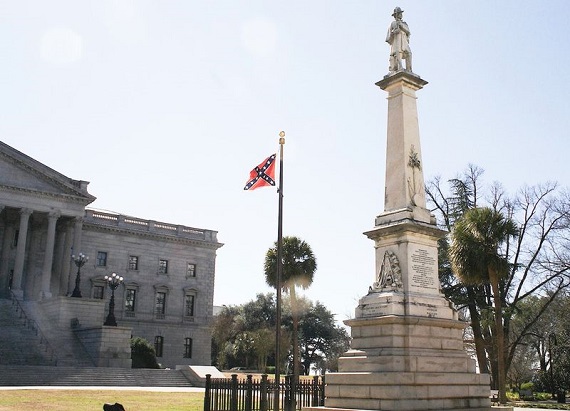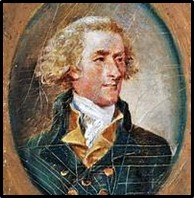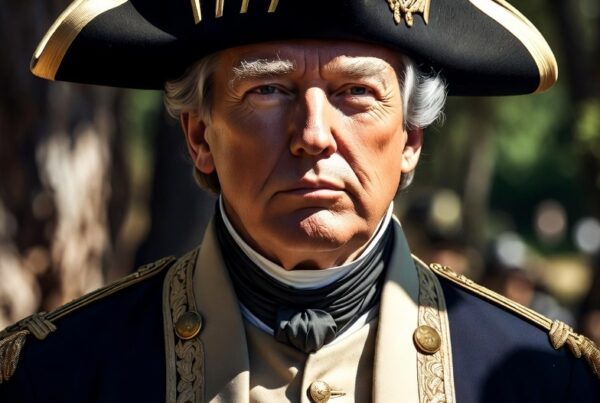
In the summer of 2015, a 60-year old former-member of the American Service and retired-electrician determined on a course that would result in a pedestrian protest from his home in the state of Alabama, culminating in the hall of the Jefferson Memorial in Washington D.C. In response to the removal of the Confederate Battle Flags from the Alabama state capital at Montgomery, this private citizen was inspired to carry just such a colour in a personal campaign for Southern heritage awareness and appreciation, an advocacy of conservative social/religious/political practices, traditional interpretation of and enactment from the US Constitution, and disfavour with the Obama Presidency. His name was John Adam ‘Johnny’ Cooper, but he came to represent the physical embodiment and spirit of ‘Johnny Reb’ to his many modern-day supporters and well-wishers. The Flight of Freedomseed, is the autobiographical account of his demonstration of, and commitment to, peaceful protest.
Cooper’s book, (the title of which comes from the name he applied to his march and colours), utilises a first-person, descriptive text account of the events of each day, through humorous text. The writing style of the work intentionally conveys to the reader the impression of a documented tape recording of his account; the book reads as if Cooper’s voice was literally recounting his adventure. For example, a mealtime encounter with local police is recounted as, “…Coming from the lowest rung of society’s ladder, my initial instinct upon law enforcement approach is to seek an exit.” (1)
Of Confederate American and Cherokee Nation heritage, Cooper’s journey would draw out both ‘wings’ of the polarised elements of the contemporary American landscape. Cooper never shies from making public his highly-partisan views against liberal measures, (such as the Obama administration’s foray into creating a universal health care system and the Supreme Court of the United States’ legal ruling in favour of same-sex marriage), during his symbolic march to the nation’s capital. His march became a commitment to conservative values, mile after mile, down American highways. Cooper personally felt himself to be shouldering not just these, and not just an American flag, but the whole of Confederate heritage and history, “…Jackson…the greatest field tactician of the entire war…Marse Robert, the very heart and soul of the South, no greater General has EVER been born on American soil…Davis…our only President…the love that those who died for this flag gave in their ultimate sacrifice.” (2) In the final stretch of his journey, Cooper found himself singing aloud in chorus to ‘Good Ol’ Rebel’, which may not be a sacred tune to many readers. And yet, the most powerful theme of Johnny Reb’s journey lies in what is lightly scribed, yet heavily implied; the worth and importance of peaceful protest.
Against the backdrop of violent public revolt in the city streets and onslaughts upon the nation’s Capital, contemporary America seems no longer to value the aspiration of being, ‘a nation of neighbours’. Social and cultural denigration have apparently rendered robust debate, assertiveness, communication, compromise and magnanimity as outdated and de-valued principles of a bygone era, rather than as central to democracy and peaceful society. To be sure, the contemporary reader of more liberal or left-wing persuasion is sure to blanch at several points in the book. (3) Cooper shied from conflict at no point, either during his march, or in his written account. Freedomseed documents his confrontations with protestors fully, including at one point, where he engaged in a street fight along the highway. (4) While it may be tempting for the reader to interpret this as a symbolic battle between the Lost Cause and False Story schools of Civil War/War Between the States, to his credit, Cooper regretted his involvement in this incident and bore no grudge against his adversary. (5)
Nearly every belligerent comment, horn blast from a passing vehicle directed at Cooper as he trudged mile after dusty mile in the sweltering heat and sun was returned with a reply, “God bless y’all…have a nice day”, or an assertive response, at most. (6) At many intervals, Cooper related having frank conversations with individuals whom brought forth disagreeing views of the Confederate Battle Flag he carried, some of them Black Americans. A number of them carried away new-found respect and appreciation for the historical arguments he posed. (7) Cooper extolled in public and private at length his absolute intolerance for racism, bigotry and prejudice. (8) A Black American reporter was subjected to the same abuse as Cooper encountered, with projectiles launched at him from passing drivers. (9) Amidst these tirades, among those who would stand with Cooper was US Congressman Benjamin ‘Cooter’ Jones, whom played the iconic mechanic on the television program, ‘The Dukes of Hazzard’. Representing ‘They in the Gray’, Cooper and Cooter met at Bulls’ Run National Park Battlefield, posing for a photo in front of the statue of their mutual hero, General ‘Stonewall’ Jackson, the Pemulwuy of the South. (10) Seven years on, Cooper’s peaceful protest and engaging with those whom disagreed with him to attempt to understand and/or resolve interpersonal differences is still inspiring.
In its very metaphoric allusion to ‘seeds’, (symbolic elements connected to the Civil War/War Between the States, such as sacrifice, familial separation, conflict and respect-through-strife), Cooper’s journey culminated in striving to reach, “…the place of Peace, Profound…” (11) Against the recent backdrop of vicious, malicious damage to public and private property, with violent revolt and confrontation being the norm on American city streets and the literal seats of democratic rule being besieged, Freedomseed, highlights precisely what Americans, and all citizens of the world, have spurned in contemporary times, and yet may aspire to, for their homes, their country and each other: A land and a people whom can assertively posit their differing notions. While dispute and conflict may well be inevitable in the course of life, all whom this may embroil never lose sight of the fact that their homes and communities are ultimately intertwined with each other; a nation of neighbours. (12) Cooper ends with an account of how he was raised to oppose racism.
The Flight of Freedomseed, may have specifically documented the journey for America as Cooper himself would prefer it, but the book reveals an important moral for all, regardless of historical interpretation, politics or culture of the individual. In stark contrast to recent displays on American city streets and its capital, Cooper exemplified in his championing of peaceful protest that, in being presented with the choice of either the path towards a ‘nation of neighbours’, or the road to becoming akin to, ‘the boys of Belfast’, his decision was firmly the former.
Lest We Forget
The Blood Price & Death Debt
Respect & Honour for They
Who Wore The Blue & The Gray
They Sleep, Forever
In The Hall.
Americans, All.
************************
NOTES
(1) Cooper, John, The Flight of Freedomseed, Self-Published, 2015, 102.
(2) Ibid, 87, 145, 179.
(3) Ibid. See for example Cooper’s stance on abortion, page 62, 286; Justice Roberts of the US Supreme Court on page 78, or then-President Barrack Obama, pages 53 & 265.
(4) Ibid, 72-73, 179-85, 313.
(5) Ibid, 184-85.
(6) Ibid, 61, 63, 66-67, 256.
(7) Ibid, 47, 63, 66-67, 69, 72-73, 88-90, 108-09, 135-36, 149-50.
(8) Ibid. See pages 228-30, 315-17, for example.
(9) Ibid, 63
(10) Ibid, 277-84. For an overview sense of comparison between Jackson and Peumulwuy, the Aboriginal Warrior/Elder of the Gadigal Peoples’ of the Eora Nation, (the area largely correlating the present-day harbour and suburbs of present-day Sydney, Australia), refer to the works on General Thomas ‘Stonewall’ Jackson CSA by James I. Robertson Jr., Stonewall Jackson: The Man, The Soldier, The Legend, Macmillan Press, 1997; Alexander, Bevin, Such Troops as These: The Genius & Leadership of Confederate General Stonewall Jackson, Berkeley Caliber, 2014; www.nma.gov.au/defining-moments/resources/Peumulwuy [Accessed 25 January 2022]; Sun-Herald, 16 February 2008, [Sydney, New South Wales, Australia]; Gapps, Stephen, The Sydney Wars: Conflict in the Early Colony, 1788-1817, New South Publishing, 2018. If the parallels of the two warriors and the forces they led be accepted, though separated by both half a century and globe, it would appear that the famed ‘rebel yell’ is but one common heritage marker. On page 65 of his book, Gapps’ writes of a clash wherein a war party of about 50 Aboriginal Australians whom, ‘“…made a great noise”, as they advanced on the Europeans.’
(11) Daley, Victor, ‘Eureka’, The Bulletin, 19 January 1911, Vol. 32, No. 1614 (Australia).
(12) Mifflin W. Gibbs, a 19th Ce. Black American Abolitionist, advocate of Black Colonisation and colleague of Frederick Douglass had described the same yearned-for sentiment following Appomattox, “…General Grant’s campaign ended in the surrender of General Lee, and Peace, with its golden pinions, alighted on our national staff.” Gibbs, Mifflin W., Shadow & Light: An Autobiography, Washington, 1902, 79






Where can one get a copy of his book? I googled it and couldn’t find anything but this article. Very little on the internet about him as well. But I enjoyed your telling about him.
Thanks!